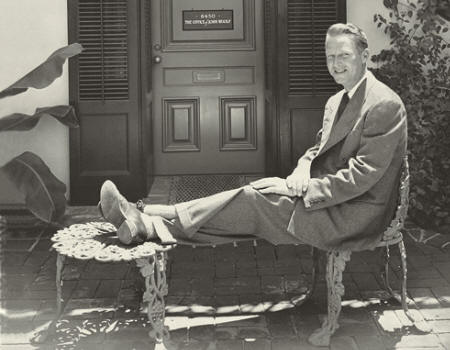

Partner Robert Koch Woolf
Queer Places:
Woolf, John E. and Robert K. House 1001 Angelo Drive (Los Angeles, Calif.) 1960-1964
Woolf, John E. and Robert K. House 9554 Hidden Valley Road (Beverly Hills, Calif.) 1962
Woolf, John E. and Robert K. Office and Residence 8448-50, 50 1/2 Melrose Pl. (Los Angeles, Calif.) 1945-1949
Woolf, John E. and Robert K. House 743 North La Cienega (Los Angeles, Calif.) circa 1960
Woolf, John E. and Robert K. House 218 Strada Corta Road (Los Angeles, Calif.) 1971
Woolf, John E. House 9425 Sunset Boulevard (Beverly Hills, Calif.) 1955-1956
Woolf, John E. House 9419 Sunset Boulevard (Beverly Hills, Calif.) 1954
Woolf, John E. House 965 North Alpine Drive (Beverly Hills, Calif.) 1967-1969
Woolf, John E. and Robert K. House 9366 Readcrest Drive (Los Angeles, Calif.) 1957
Woolf, John E. House 704 Arden Drive (Beverly Hills, Calif.) 1975
Woolf, John E. House 634 Stone Canyon (Bel Air, Los Angeles, Calif.) 1978
Woolf, John E. House 1230 Laurel Way (Beverly Hills, Calif.) 1969
Woolf, John E. House 1011 Crescent Drive (Beverly Hills, Calif.) 1952-1953
Woolf, John E. House 325 North Carolwood (Los Angeles, Calif.) 1969
Woolf, John E. and Prophet Associates 812 Crescent Drive (Beverly Hills, Calif.) 1953
Forest Lawn Memorial Park
Glendale, Los Angeles County, California, USA
 John Elgin Woolf (January
4, 1908 – September 24, 1980) was an American architect noted for the Hollywood homes he created with partner and adopted son
Robert Koch Woolf.
John Elgin Woolf (January
4, 1908 – September 24, 1980) was an American architect noted for the Hollywood homes he created with partner and adopted son
Robert Koch Woolf.
After receiving his bachelor's degree in architecture from Georgia Institute of Technology in 1929, Mr. Woolf (known as Jack) moved to Hollywood, hoping to pursue a career in film. Hoping his Southern background might prove an asset in filming Gone with the Wind, he met the film's first director, George Cukor, who was instrumental in helping Woolf meet other influential people in Hollywood who later became his clients. In the late 1940s, Woolf met Robert Koch, an interior designer. They became partners and together built or renovated homes for many of the wealthy and famous Los Angeles area residents of the 1950s and 1960s. They "established a new vocabulary for glamorous movie-star living; they synthesized 19th-century French, Greek Revival and Modernist touches into a heady mixture that has since been christened Hollywood Regency, which foreshadowed aspects of postmodernism."[1] One of their most notable renovations was Case Study House No. 17, the largest and most technology-enhanced of the Case Study Houses sponsored by Arts & Architecture magazine, designed by Craig Ellwood and originally built in 1955.[2] Woolf and Koch purchased the house in 1962 and transformed it from its original utilitarian design to their own more glamorous architectural style, which they used for their own residence.
Woolf designed homes for clients Cary Grant, Errol Flynn, Judy Garland, Barbara Stanwyck, Ira Gershwin, Fanny Brice, Bob Hope, Agnes Moorehead, Ronald Colman, Jean Howard, Lillian Gish, Mervyn LeRoy, Paul Lynde, Ray Milland, Ricardo Montalbán, Loretta Young, Katharine Hepburn and Spencer Tracy. Bob and Dolores Hope hired John Elgin Woolf in the 1950s to remodel and update their 1939 Robert Finkelhor-designed house in Toluca Lake.[3] Additionally, many Hollywood builders of the same era imitated the style created by Woolf, which typically featured his "Pullman doors" front entry, leaded oval glass window, mansard roofline and Doric columns.
Robert Koch Woolf was Jack's partner and lover. In 1971, after being diagnosed with Parkinson's Disease, Woolf adopted Koch and Gene Oney Woolf, who had come to reside with them, in order to legalize their relationship and formally establish a family. A later household member, William Capp, was included as a "brother," although never formally adopted. This became known to friends as the "Woolf Pack" and is still present in Hollywood vernacular.[4]
My published books: